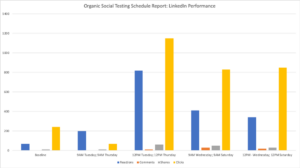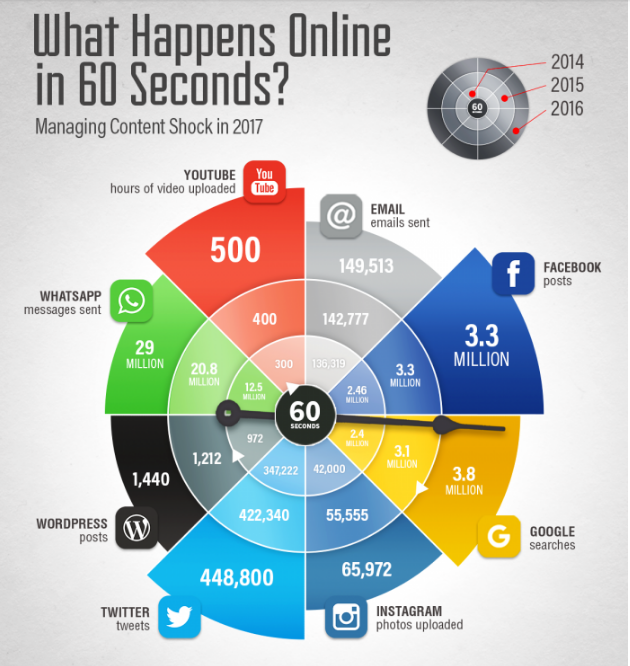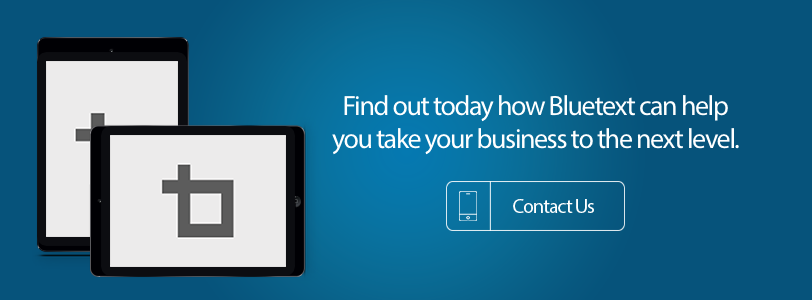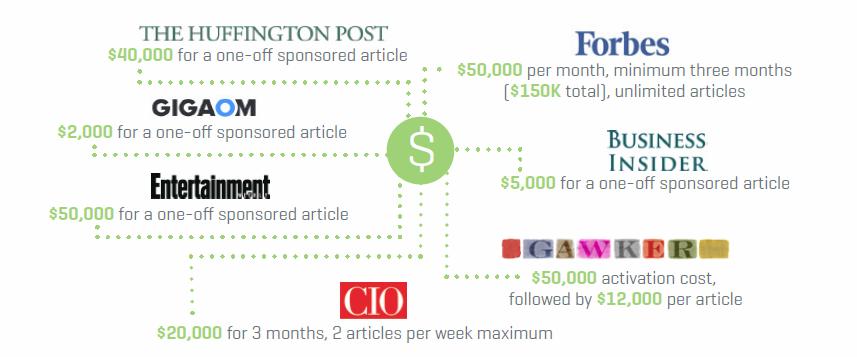Driving engagement and other key metrics through organic social media is often an important component of a marketing campaign that targets business executives as its target audience. It complements any paid social or media, helps build awareness, and motivates target audiences to click through to a website or other campaign assets.
The question is, how do you determine the best timing in order to get the best results? This is especially tricky, given the short shelf-life of a Tweet, a Facebook post, or a LinkedIn feed. There are many myths regarding when to post organic social to drive the best results for a marketing campaign. Most of them are based on old, out-of-date assumptions, or gut instinct. Bluetext decided to test these to get hard data behind our campaigns.
The Old Common Wisdom on Social
There are some older pieces of conventional wisdom that have become ingrained in practitioners and that date back a dozen or so years to when social media campaigns were relatively new. Here are a couple that seem to make sense, but that we thought might be outdated given today’s “always-on” business culture:
- Don’t post on Mondays or Fridays. On Mondays, people are busy getting ready for the week and are likely to miss the posts. On Fridays, people are leaving early or checking out for the weekend. And never expect them to engage over their busy weekends.
- Avoid first thing in the morning and late in the day. It’s better to try other times when your target market isn’t so busy or trying to clear out of the office to get home.
Why We Wanted to Test Those Assumptions
Ultimately, we weren’t convinced that the older conventional wisdom was still valid. People work more flexible hours now than previously and are on-line and multi-tasking on a regular basis. Here at Bluetext, we wanted to get real data for ourselves so we could make the best recommendations for our clients.
How We Designed the Test
Working with a large client whose target audiences include business executives in the retail space, Bluetext designed a test that would send out social posts across three platforms where the client has a significant presence and following:
We did this over a four-week period, sending out those posts at a different time of day each week. For Facebook and LinkedIn, we also send out posts on different days of the week to see if and how that might make a difference. We looked at re-posts, replies, likes and link clicks.
The Results
Contrary to the conventional wisdom, the best results for the test’s Tweets were for those posted at 9:00 am and pm weekdays, outperforming those sent at 8:00 am, noon, or mid-afternoon.

The best results for LinkedIn were for those posted at noon on Tuesdays and Thursdays but other positive results for 9:00 am on Wednesdays and Saturdays.

For Facebook, the best results came at noon on Tuesdays, Wednesdays, Thursdays & Saturdays.

How to Leverage This New Data
Focus social posts around those best times and dates for each platform, but don’t ignore the other times or days of the week. Although posting content during “off-hours” might not deliver as much engagement, they will help to build awareness.
Transitioning a company that specializes in a product or service from working in the private sector to one that wins government contracts is no easy task. Negotiations can take months as organizations have to jump through a plethora of hoops to get contracts and budgets approved. Governments also favor companies with whom they’ve worked before or who have had experience operating as a government contractor in the past.
This begs the question — how does a company, perhaps one who doesn’t have as much experience working in the public sector, catch their attention and earn a place at the table? The answer is Content Marketing. You, as a government contractor, can offset your inexperience in the government contract realm via content production. This content can range from blogs to white papers; from videos to infographics; anything and everything that demonstrates your expertise in a given subject and gives you the upper hand over your competition. Most contracting officers, when looking for the right company to reward a contract to, will conduct research, looking at different options with three main criteria in mind: risk mitigation, brand reputation, and visibility.
Getting noticed by contracting officers doesn’t happen overnight, however. Building brand awareness and gaining reputation takes time and effort, and the content you produce must be created with the contracting officer in mind. Knowing who those specific agencies are that you’re targeting and specializing your content for them can set you on the right path from the outset and get you closer to winning those highly coveted government contracts.
Risk Mitigation
When a government agency decides to partner with a new government contractor, the biggest concern they have is mitigating the risk of working with a new partner. Their main goal is to get their contract fulfilled promptly without going over budget. Risk is usually mitigated by choosing to work with a partner they’ve previously worked with, or by working with someone who has a reputation for doing good work on government contracts. If you don’t necessarily have the experience of working in the public sector, you can mitigate as much risk as possible by proving to the client, through content that you produce and they are exposed to, that you have the expertise to handle the work and that you’re able to fulfill the contract and meet the government agency’s demands.
Brand Reputation
Ensuring that your company’s brand is being communicated to your desired audience in the way that you want is crucial when looking to attract government contracts. Although you should not aim to win every contract that comes along, you can set yourself up to showcase your abilities in the shop window using content on your website to prove your worth and show that you do have what it takes to work with government agencies and provide them with the products or services they require. Believe in yourself, your company, and your brand to get the job done, and make it known that you are the go-to company in your field. Create content that showcases your work in the commercial industry and educates readers on how that same success can translate to the public sector.
Visibility
To prove your reputation, you must be visible to your potential clients. You may have the best product or service in the business, but if you don’t have an active presence online, and you’re not showcasing your expertise, it’s not going to get you anywhere. Creating content on your site and sharing it through your social media channels can have a remarkable effect on your brand’s visibility. Sharing news and blog posts to your email subscribers build your brand awareness and attract potential new clients. Do everything and anything to increase the visibility of your brand and drive contracting officers to your site and to the content that you’ve created to show off your products and services.
Bluetext: your leading government contractor branding agency
That’s where Bluetext comes in. With years of experience working with government contractors, Bluetext is your one-stop-shop branding agency for content production. When NetApp, a cloud data services and data management company, had grown its offerings within the market, they turned to Bluetext to partner with and help inform public sector decision makers of the capabilities of their new solutions. Bluetext helped NetApp develop news stories, authored by NetApp experts, to key publications that both educate readers and inform decisions. Through our combined work, we helped position NetApp as a recognized thought leader within the government space.

Content production for experienced government contractors
Bluetext also has a background of working with large, experienced, well-known government contractors. Take our work with ManTech, for example. ManTech is a multibillion dollar public company that provides subcontracted technological services to the government. We partnered with them to produce a series of branded videos for their new website, highlighting their capabilities in one cohesive and powerful story.
Showcasing your abilities to government agencies
Cisco turned to Bluetext when they were looking for help showcasing how their solutions directly address the global networking requirements for the U.S. Federal Government’s integrated intelligence and operations functions. We worked with them to develop a visually appealing storygraphic, which included an interactive wheel to demonstrate the integration and impact of Cisco’s solutions across air, land, and sea to help the government achieve end-to-end mission success.

From veteran-owned SMB to big-time government contractor
One of our more recent projects involved Invictus, a cyber and national security firm, who turned to Bluetext to embark on their next mission: grow from a veteran-owned small business to full-service government contractor. Not only did we update their logo, reimagine their corporate visual identity, and design a modern website, we also created a corporate video that showed their clients exactly who they are, what they stand for, and what they can do for them.
Proving expertise through content
Showing potential end-users proof that your company possesses the grit, determination, and expertise to successfully execute contracts is vital for any company that wants to win government contracts. Expertise is often shown through experience; however, experience can be supplemented with relevant and actionable content on your website. If you can prove that you know the subject matter, agencies will treat you like a veteran government contractor and have faith in you to carry out their contracts. Partnering with a branding firm like Bluetext, who has the experience and expertise in working with government contractors both large and small, can help you achieve your goal of getting your company’s name on the shortlist for that government contract.
To view more of our work with government contractors and how we can partner with you, visit our website today.
There’s good news and bad news for companies hoping to make their mark in the cyber security universe. First the good news: The market for these products is huge and growing exponentially. Security Analyst and researcher Richard Stiennon, in a column on Forbes.com and extrapolating from Gartner data, projects a ten-fold increase in IT security spending over the next 10 years- to $639 billion annually by 2023. That’s a number that would have any company executive working overtime to tap into.
But here’s the bad news: This is not exactly a secret. The competition is fierce and growing, as the growing number of solution providers races to meet this demand and take advantage of the opportunity.
It’s easy to have a marketing plan that pushes key messages out to prospective customers. At Bluetext, we think an influencer strategy is essential as part of that plan, and especially in such a crowed space as cyber security.
How any company—from established household names to challenger brands—can break through the noise and the clutter to attract the attention of this market requires an engaging and creative marketing approach that clearly sets it apart and above the competition. This demands a fine understanding of the value it brings to its customers and why it’s the best solution for any particular challenge.
Yet, simply having great creative is only half the battle. Getting that message out to the market is a whole new challenge, and needs both a direct approach and an in-direct strategy—the bank shot to reach the intended audience. Direct tactics are obvious—direct mail, email blasts, online and print advertising, a digital presence, trade shows and webinars; these are all direct appeals to potential customers.
The indirect approach is in many ways more difficult. It requires using industry influencers to reach their larger audiences with your content and messages. That is no small task, and it takes a dedicated investment in time and research. Here are some of the required elements to implement an effective influencer strategy:
1. Identify the best influencers for cyber security.
2. Recruit those influencers as allies and advocates for your thought leadership.
3. Engage those influencers through social media and direct outreach so that they will spread the word to their audiences.
Let’s take these one at a time.
Identify. Identifying the right influencers for any market, and in particular for cyber security, takes some research and digging. The key is finding the leaders who not only have the most followers on social media, but whose content—including tweets, blog posts and news articles—are shared the most frequently. When Bluetext executes an influencer campaign for its clients, we look first at the number of twitter followers and LinkedIn connections for each influencer candidate. But that’s only our starting point. More important is researching their history of shares among that audience. If a particular individual has a large number of followers yet few who share and rebroadcast that content, it could mean that his followers don’t find his content to be valuable, or that he doesn’t post content very often. If there are a lot of shares, retweets and comments, that’s a good indication that the person is read and taken seriously across the industry.
Recruit. Recruiting an influencer doesn’t mean offering them a job. It means building a relationship so that that person knows you are reading his content and pushing it out to your audience. The best way to do this takes work. The first step is to follow that person on Twitter, and to subscribe to his feed if he has a syndication service. The second step requires that the person’s content be reviewed on a daily basis. Any time there is a post that is relevant to your market, share it, follow it, retweet it, comment on it or call it out and add your own perspective. The idea is demonstrate that you are an active fan and follower who is paying attention to the expert.
Engage. Engaging with the influencer is a long-term project. After you have shown interest and built a credible track record of reading and sharing his content, he can be approached as an industry expert, a colleague and a reporter. That might include asking for his opinion on a new development, offering to share an announcement that he might find interesting, and even giving an advance look at a new piece of research or development. The goal is to be viewed the same way that a reporter would view a valuable source—with credibility and interest. When that engagement is solidified, the influencer is much more likely to pay attention to your content and to share it with his audience.
This may seem like a cumbersome process, and Bluetext dedicates a fair amount of energy to make this happen for our clients. But the payoff is significant. Using the bank shot to reach a much broader audience through sources that they trust can help rise above the competition in a crowded and growing market. A smart influencer strategy takes time and commitment, but it’s worth the effort.
A lot happens every 60 seconds online across digital platforms. In fact, a staggering amount of posts, uploads and emails take place in the space of a minute – every minute of every day. By looking at this data in detail, and comparing trends over the past three years, marketers can glean a lot of useful insight as to where to focus their brand’s attention when developing media programs – whether for specific targeted campaigns or for ongoing outreach.
A collection of these stats across the most important platforms was recently published by SmartInsights, and it reveals some significant trends. First and foremost, the 800 pound gorilla platform in terms of activity isn’t Twitter and it isn’t email. It’s Facebook. While there are nearly 450,000 Tweets every minute, there are 3.3 million Facebook posts in that same amount of time. In fact, if you said that Facebook literally dwarfs the other contenders, that would be accurate.
 Except when it isn’t.
Except when it isn’t.
As the stats show, the outlier that is the largest by far is What’sApp, the free cross-platform app that can do just about what every other app does, and encrypt it in the process – with more than 29 million messages sent every minute. It’s widely popular around the globe (although not so much in the United States yet).
And who owns What’sApp? Facebook, of course. See a trend here?
60 Seconds Online: Where to Focus?
So where to focus your media campaigns? Look at some of the trends for what’s growing the fastest, and what’s being left behind. For example, Twitter’s 2014-2015 growth line came way down for 2016. Yes, there are more Tweets than a year ago, but not by much. Facebook shows no growth from 2015 to 2016 – which could mean that it has reached its upward potential. On the other side of the spectrum, YouTube and Instagram have increased their activity significantly.
Let’s not forget – Facebook also owns Instagram, while Google owns YouTube. So the upstarts are really just growth opportunities for the giants who continue to battle it out for dominance.
What does all of this mean for marketers? We tell our clients to look at where the growth is, not what was hot two years ago. Twitter is great for sports, entertainment and politics, but not so strong for b2b marketing. Instagram, on other hand, is expanding its reach across demographics, and can reach new target audiences that may have not been a focus of previous campaigns.
Thinking about your marketing and media mix? Contact Bluetext
In a recent post, Bluetext Creative Director Jason Siegel described the differences between a top digital marketing companies, top marketing companies and top marketing agencies. The answer was in the range of services they provide. In this post, we’ll answer another frequently asked question: What’s the difference between a marketing firm and a marketing agency? This is more than a trivial question, and and it can be confusing. But here’s one reason why it is an important question to address: The term “marketing firms” (as well as “top marketing firms”) is by far the most widely used search term when looking for information on vendors that provide marketing services.
In the traditional use of these terms, there was a real difference. Agencies were typically made up of a collection of “agents,” or independent individuals who operated under one brand for their own marketing and support services. Think about insurance agents who all sell State Farm services but run their own separate businesses. The same is true for real estate agencies and investment services. All sell one brand’s services, but in the traditional sense act as their own companies doing so. Firms, on the other hand, tended to include individuals all working for the same company as employees (or partners). Yet, this hasn’t been the cases in marketing for several generations.
What’s particularly interesting about the use of the term is that most companies that provide these types of services–including Bluetext–don’t refer to themselves as firms, but rather as agencies. There are several reasons why we prefer the term “agency” over “firm”, none of them scientific or based on a common standard of use. First and foremost, a firm implies a smaller group of specialists that provide a limited range of services, in this case in the marketing field. It can be high-level strategy, but often not wide-spread implementation or execution. In other words, it limits the company in terms of perception about what it looks like and what it does. So for example, a research firm will only provide that type of service, while a communications agency might include research in its full scope of services. In the case of Bluetext, we provide a full-range of marketing and communications services–including high-level strategy–that includes implementation and not just consulting.
Second, the term “firm” is more often used to describe a smaller company that specializes in traditional public relations services, so that “PR firm” is an accepted term for those types of service providers. As a provider of a full range of marketing services, including public relations and media outreach, the use of the term “marketing firm” is too limited for what we do. Marketing firms like ours do so much more than that, we cannot take the chance of being confused for a pure-play PR firm.
For clients, it’s important that they recognize this distinction so that when they are looking for the right marketing partner, they know they are getting one with the broadest range of services. We tell our prospects that the advantage of an agency like ours is that once we understand your challenge, the problems you are trying to solve and the successes you are trying to achieve, we can craft an integrated campaign using all of the marketing services that will allow you to reach those goals. That might mean a combination of traditional public relations, content marketing, advertising and paid syndication, and a digital campaign to reach the target audiences. Only a full-service marketing agency can provide that type of solution.
And in today’s communications landscape, there is no one magic bullet to drive customer engagement. It takes a range of options and approaches that require a full-service agency, and not a specialty firm. To learn more about the range of services Bluetext offers and view our Hall of Fame.
Bluetext’s Chief Creative Officer, Jason Siegel will be speaking at MediaPost OMMA VR/AR in New York during Advertising Week on September 28th.
MediaPost saw the need for an event focused solely on Augmented and Virtual Reality as these new mediums have taking the marketing world by storm. The event will explore how marketers can take Virtual and Augmented Reality from the novelty phase into an opportunity to enrich branding and deepen consumer relationships.
Jason will be part of a panel discussion titled “Retailers Follow Pokémon Go”, which will examine the overwhelming success and influence of Pokémon Go, and how retailers can learn from this case study and incorporate AR or VR experiences into their marketing strategy to appeal to in-store shoppers.
Other topics the event will cover include:
- How different types of VR/AR experiences map against specific brand goals.
- Where do you start…small?
- How to distribute experiences efficiently and connect VR/AR campaigns to other marketing platforms and programs.
- Who are the players and how should marketers and agencies vet them?
- Storytelling in 360 degrees
Make sure to tune in for the conference live-stream on September 28th at 4:00pm EST here. And to learn more about Bluetext’s VR work, contact us today:
It’s been an exciting summer here at Bluetext, and to top it all off, our Chief Creative Officer Jason Siegel is speaking at BizBash’s Elevate DC 2016 on August 3rd about his ideas and insights on the many cool things happening in our office and the industry in general. Jason will head to the Reagan Center here in Washington on August 3rd to participate in this one-day conference for meeting and event professionals. Filled with engaging speakers from a variety of industries, Elevate DC promises to be a great time, and Bluetext is honored to participate.
Jason will speak about “The New Rules of Social Media and Event Marketing”, sharing the way that social media engagement and other innovative marketing strategies can help businesses drive interest and registration for events. Following up on Bluetext’s recent virtual reality campaign for Varonis, Jason will discuss how to seamlessly integrate VR into an event marketing strategy. He will also be exploring how to use a three-part, campaign-style approach to maximizing event reach and creating urgency to register.
To see Jason’s presentation and the many other great speakers coming to Elevate DC this year, you can register here. And to learn more about how Bluetext is on the cutting of VR, reach out today:

This goes to the heart of every company’s SEO strategy. The clues come in a patent filing for something called an “implied link.” Before I explain why this is important, let’s first take a trip back to the early days of SEO and link-building.
Early on, Google would evaluate where a site ranks for any given search by looking at how many other sites were linking back to that page. If you were a valuable site, visitors would link to you in order to share that with their audience or to cite you as a good resource. That type of analysis would seem like an obvious way to measure the quality of the site.
But SEO gurus are always trying to stay one step ahead, and once link-farms and other shady techniques for creating myriads of back-links became prevalent, Google recognized that there’s no way to verify whether a link was added because a user genuinely likes the content or whether the link was paid for. The quality of a link can be corrupted through a wide variety of Black Hat tricks, and thus the value of all links came into question.
And while Google has updated its algorithms on numerous occasions over the years, that doesn’t mean that links aren’t still valuable for SEO. They are just much less valuable than they once were. Google is now much more selective about the quality of the site that is doing the linking. The New York Times continues to be the gold standard for the most valuable links.
But what if a publication like the Times mentions a brand or its product without a hyperlink? Shouldn’t that carry some weight, even though it doesn’t include a url?
That’s where Google’s patent comes into play. SEO insiders believe that the patent is related to last year’s Panda update, and that it describes a method for analyzing the value of “implied links,” that is, mentions on prominent sites without a link.
Let’s say the Times mentions in an article the website of NewCo as a great resource for a particular topic, but doesn’t include a link to NewCo’s website. Previously, there really wasn’t a measurable way for NewCo to benefit from that quality mention. With implied links, Google sees the mention in the Times article and factors that into its search ranking.
Implied links are also used as a sort of quality control tool for back-links in order to identify those that are most likely the result of Black Hat tricks. For example, if Google sees numerous incoming links from sites of questionable quality, it might search for implied links and find that no one is talking about that brand across the internet. Google looks at that evidence from the implied links to determine if the back-links are real and adjusts the rankings accordingly.
Here are four tips for adapting to Google’s focus on implied links:
• Don’t abandon your link-building strategy. Earned links are still effective when they come from valued sites. The most valuable links will still be for relevant, unique content.
• Brand reputation is key. When asking for mentions on other sites, try to have them use your brand name as much as possible. The same is true when you are posting on other sites. Use your brand name. Do the same in descriptive fields such as bios at the bottom of contributed content.
• Engage your audiences in conversation. Similar to word-of-mouth marketing, the more your brand name is being mentioned, even without links, the more it will benefit your SEO. Encourage that conversation as much as you can.
• Be creative and flexible. Google is always evolving its search engine algorithms. It’s difficult, but not impossible, to predict how they may change over the next year, or how effective today’s best practices will be tomorrow if you know how to follow the clues.
If Jon Favreau’s character in Swingers met sponsored content at a bar a few years back and snagged its phone number, he might pin the number up on his calendar, but he would never call her. Ever. Because sponsored content lacked brains, beauty and charm.
But sponsored content – and content marketing in general for that matter – has come a long way from its origins as glorified and often ineffective native advertising. Today, Vince Vaughn’s character would take a look at sponsored content, hop up on the table, swing his shirt around and yell, “You know what big boy? You’re grown up. Cuz you’re growns up and you’re growns up and your growns up!”
While Vaughn’s sentiments will have once again obliterated the English language, his point would be well taken. Sponsored content has “growns up.” Publishers are taking sponsored content very seriously because it has become key to their financial lifeblood. Desperation leads to innovation, and experimentation – all good news for brands reluctant to part with traditional advertising dollars but that increasingly view mature sponsored content opportunities as a way to reach and influence target audiences.
In a recent interview, AOL Inc. CMO Allie Kline reaffirmed its view that content marketing is not advertising. While some of the campaigns she references stretch the limits of how we define content marketing, that is kind of the point; the definition is changing as the data, distribution and content becomes more sophisticated.
Sponsored content is one component of content marketing. Sometimes it is easily identifiable, while in other cases the sponsored content is cloaked within traditional editorial content. The latter development is a testament to the fact that display ads and other overt forms of online advertising are falling out of favor, and brands increasingly seek a way to have their content woven into earned editorial content, where it is less obvious to the reader, viewer, listener that the content is in fact “sponsored.” When was the last time you clicked on a banner ad? For me, it only happens when the web page I’m viewing shifts unexpectedly at the last second and causes me to click on an ad rather than the editorial content I actually wanted to read.
In our work with clients, we’ve been increasingly evaluating and making recommendations on sponsored content for technology brands. Based on this work, there are a few considerations brands should keep in mind when embarking on a sponsored content program.
Publishers are upping their game
Traditional publishers are no longer ceding the curated content game to agencies and other players in the market. Look no further than The Guardian, a well-known global publication that in 2014 launched Guardian Labs, an in-house branded content agency. Brands such as Silence Circle, a hot encrypted communications firm, chose Guardian Labs this year for a sponsored content program to promote the company. It is reported that Guardian Labs has 133 staff members, and there is no doubt that other publications will be closely watching efforts such as these to gauge whether they can launch similar efforts.
Similarly, QZ.com, an up-and-coming news and tech site, has teams of content, video and design experts working with brands such as HP on this infographic-anchored sponsored content, to build high impact sponsored content that will grab the reader’s attention. So what brands see today is a far cry from advertising and the full page “advertorials” that had an editorial flavor to them, but were still noticeably out of sync with a publication’s earned editorial content.
The details are in the fine print
TechCrunch, Forbes, Re/Code, CIO.com, you name the technology out let and most likely there will be a sponsored content option. Before selecting one or more outlets to work with, the brand should get answers to several key questions:
- Where will the sponsored content post direct the target? Some technology outlets will redirect users clicking on the sponsored content teaser to content that resides on the outlet’s site and looks and feels similar to earned editorial content on the site. The benefits to this approach
- What type of sponsored content works best? Sponsored content can, in theory, be self-promotional about a company or product, or it can be more traditional thought leadership whereby the goal is to attach the brand to a vision or market trend. While one could argue that self-promotional content can more directly link the target to a buying action, doing so makes the sponsored content more “ad” like relative to thought leadership content.
- What happens to the sponsored content post? A typical sponsored content scenario is that the teaser will appear in a vertical scroll within the top 10 news stories on a technology site. Brands must understand how long the content sits in that position, what happens to the content after it leaves the prime position and is shifted to another part of the site, and whether this content leads to another part of a site or an external landing page the brand (or publisher) most construct for this campaign. In some cases, a sponsored content piece might only run in prime position for one day, so understanding where the content travels to from there is key.
- Do they use CPM or fixed-fee model? In some cases, editorial outlets will use the ‘cost per thousand impressions’ fee structure, while in others it is a set fee determined by the publisher based on a broad range of factors. Each model has pro’s and con’s that should be evaluated.
Do listicles work for b2b brands?
List + Art (icles), otherwise known as listicles, have exploded on the b2c side of the house. Scroll through Yahoo News or any other consumer content site and you are bound to bump into some inane list along the lines of “Top 5 ways to pay off your mortgage,” “The 8 best places to eat fried chicken without a napkin,” or “Top 10 reasons you shouldn’t eat scallops.” How much these listicles contribute to society is debatable, but the listicles are eminently clickable and work reasonably well. For B2B sponsored content however, listicles remain a work in progress and must have a more substantive theme and valuable content that relates to the user’s pain points.
Does sponsored content work?
In January of this year, a blog post by SEO firm Moz did a fantastic job of analyzing the current state of sponsored content, and the potential for brands to see stronger results relative to advertising. In its “Content Promotion Manifesto,” Moz estimated that brands spent, on average, 6.7 percent of their content marketing budgets on sponsored content in 2013– and surely that figure has increased measurable since then.
In terms of effectiveness, the Moz blog post also cites a Contently survey of Internet users that reveals brands have a real opportunity to influence decision makers with sponsored content. Nearly half (48%) of respondents believe sponsored content that was labeled as such was paid for by an advertiser that influenced the content produced. The majority felt the “sponsored content” label meant something else.
Equally encouraging is that the survey finds one-third of respondents are as likely to click on a sponsored article as they are to click on unsponsored editorial content. The Moz article also references a separate study that actually found consumers look more at sponsored articles (26%) than typical earned editorial articles (24%). Publishers have seized on the strong results and favorable consumer/business user data, charging brands five and six figure amounts for individual and limited-run campaigns (as the Moz chart below indicates).
The bottom line for brands evaluating sponsored content is to build a clear set of goals and objectives for the campaign, and identify the right partners to execute it.
Google has done it again. It has quietly released yet another tweak to its search engine that will have a dramatic impact on how a company’s website performs when viewers are searching. The bottom line for organizations: The user experience is becoming more and more important to a site’s rankings.
If you’re a marketing executive who has devoted a lot of time and resources to improving your SEO, you may find that keyword analysis and other search engine techniques are no longer enough. While still important, other site attributes may play just as big a role in where your site ranks in search results.
You may recall the last significant adjustment from Google, dubbed in the media as “MobileGeddon.” That update simply noted that a user’s experience from a mobile device was important. If a website wasn’t appropriately mobile-optimized for viewers, its ranking would be lower when a visitor was searching from their mobile device, and sites that were mobile-friendly would rank higher. That version of the Google algorithm got a lot of attention.
This latest rev has been well under the radar screen. There were no announcements from Google. In fact, it only came to light after search engine aficionados began sounding the alarms in early May, when they noticed that some sites’ rankings were plummeting. Two weeks passed before Google gave any official acknowledgment of what the company simply calls its “Quality Update.” Search engine wonks have dubbed it the “Phantom Update.”
So what does it do?
“How Google assesses quality is sometimes a thing of mystery,” writes Thomas Smale of Entrepeneur.com, “but we do know that it wants to provide users the the best information possible.”
The new Google update rewards sites that have a good user experience in addition to what it considers quality content. Having high quality content is important, but it’s also about rewarding sites that deliver a better experience, and punishing those who don’t deliver a good experience. So while redundant and thin content will get dinged, so too will sites that have self-starting videos, banner ads, and 404 errors.Here are four ways to make sure your site delivers the type of user experience that will be rewarded by Google’s search engine:
1) Get Rid of Thin Content. According to Google, this can include automatically-generated articles, thin affiliate pages, thin content from other sources such as the “scraped” content of low-quality guest blog posts, and “Doorway” pages created to rank highly for specific search queries, which Google views as bad for users because they end up taking the user to essentially the same destination. These techniques don’t provide users with substantially unique or valuable content. As a result, Google has applied a manual spam action to the portions of a site that include this type of thin content.
2) Remove Any Auto-Play Videos. Like many disruptive ad formats these are seen as providing a bad user experience and are punished by Google.
3) Filter User-Generated Content. That means having a strong moderator function for user-submitted posts to make sure that any blatant self-promotion or answers that are too general to be useful aren’t marked as spam by Google.
4) Eliminate Annoying Ad Formats. If your site begins to attract enough visitors so that advertisers want to pay for that real estate, be cautious. Excessive and disruptive ad displays, including above-the-fold ads, pop-ups, and similar techniques, are viewed by Google as a bad user experience and treated accordingly.
Websites should be designed to do what they were intended for in the first place; delivering a high-quality experience to users. That’s what Google likes and rewards in the race for page rankings.

